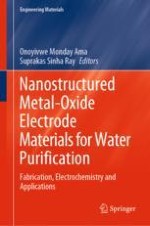2020 | OriginalPaper | Chapter
10. Metal Oxide Nanocomposites for Adsorption and Photoelectrochemical Degradation of Pharmaceutical Pollutants in Aqueous Solution
Authors : L. Mdlalose, V. Chauke, N. Nomadolo, P. Msomi, K. Setshedi, L. Chimuka, A. Chetty
Published in: Nanostructured Metal-Oxide Electrode Materials for Water Purification
Publisher: Springer International Publishing
Activate our intelligent search to find suitable subject content or patents.
Select sections of text to find matching patents with Artificial Intelligence. powered by
Select sections of text to find additional relevant content using AI-assisted search. powered by
